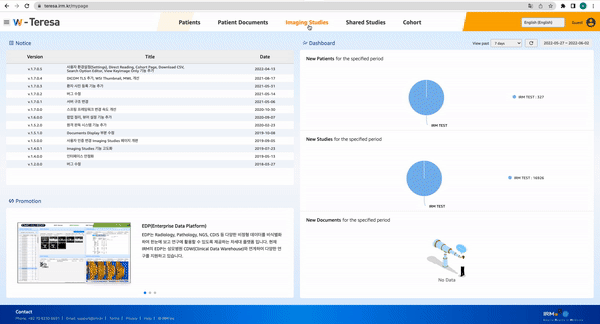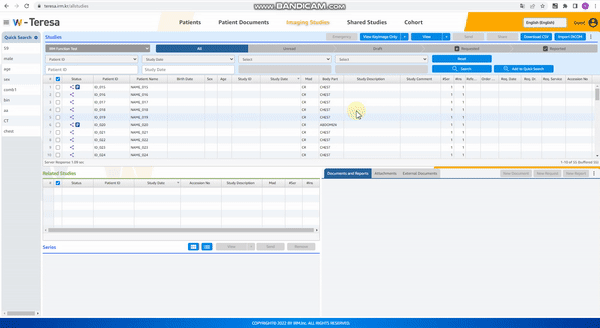How to use Cloud PACS for free?
02
Check the information email.
When you submit the application form, we will send you an email with the created account and instructions for using Cloud PACS.
If you do not receive a notification email within 3 business days after submitting the application, please contact us.
04
Use cloud PACS freely.
View inspection information in Cloud PACS, view images with a viewer, write reports, and upload images directly.
1) View inspection information

2) View video

3) Write a report

4) Upload video directly

Frequently Asked Questions (FAQs)
What is the difference between cloud PACS and traditional on-premises PACS?
Cloud PACS and on-premise PACS have different operation methods. Likewise, the usage payment method and benefits are different. Look thoroughly at the description and comparison below and consider which PACS system would fit more according to hospital, institution or clinic size.
How are they different in operation?
On-premise PACS requires internal hardware and software installation at hospitals and institutions for medical data storage. Patient digital images and related data generated by imaging devices are directly stored through an internal server. Then, patient data can be viewed through the PACS software on a computer or workstation accessible to the installed server.
Cloud PACS stores patient digital images and related data from imaging devices on a remote server over the internet. You can also log in to the PACS application through a web browser to view stored patient data.
Who shall do the maintenance?
On-premise PACS requires not only system control and management with ownership of the infrastructure but also hardware and software for storing medical data being installed inside the institution. Occasionally, depending on the increase in medical data, it becomes necessary to check the capacity of the storage. Large-scale hospitals often use on-premise PACS and IT staffs are resident for maintenance.
Cloud PACS provides services in a form that end users borrow a part of the supplier’s infrastructure such as servers, storage and equipment for the purpose of storing, managing and tracking about medical data. So the PACS supplier is responsible for infrastructure maintenance.
What are the pros and cons in terms of cost?
On-premise PACS has a higher up-front cost due to hardware and software costs. But the average monthly cost tends to be lower once the initial infrastructure is completed. It is an appropriate PACS when a large-scale hospital with a computer room and resident IT staffs wants to manage the system directly.
Cloud PACS is a form of subscription to multiple systems such as servers, storage and equipment as one product. So the initial hardware cost is lessened as well there is no need of resident staffs for system maintenance. If the medical data capacity increases, end-users may instantly secure additional capacity by applying for space extension to a PACS supplier
What are the advantages of each system?
On-premise PACS can be equipped independently in end-user’s place. It limits connection boundary as only designated computers or workstations can access the PACS.
Cloud PACS allows end-user to store, manage and browse medical data through a web. It is a convenient tool to work remotely and to transfer medical data to external users with access rights
What security are you following to protect your medical data?
For cloud PACS, it is important to ensure that the public cloud products to implement appropriate security measures. If you want to know more about the security regulations of IRM Cloud PACS, Please refere to What kind of security does IRM's cloud PACS comply with?
What are the limits of the free version?
The free version has the following limitations.
-
Storage: 10 GB
-
Number of users: 1 account
In the paid version, there will be more storages and number of users depending on the type of your plan
How can I pay for it?
A monthly fee is charged according to the storage capacity and number of users. Click ‘Contact us’ for a quote request.
What are the advantages of cloud PACS for technical support?
Since the existing installed PACS system is installed inside a medical institution, in order to check the performance degradation or failure of the PACS system , the person in charge of the medical institution first identifies it and delivers it to the PACS company. The technical support procedure is complicated because an engineer must visit the hospital in person or access the PACS system directly through remote access for regular inspection and technical support.
On the other hand, in cloud PACS, the system status is monitored in real time, and in case of performance degradation or failure of the PACS system, an engineer is notified immediately, enabling rapid response. In addition, because all system inspections and fault handling are done directly in the cloud service system, there is no need for an engineer to visit a medical institution or a separate procedure such as allowing remote access from a medical institution.
If I use Cloud PACS, do I need a communication network facility for Internet use?
Because data is stored in the cloud through the Internet and stored data is retrieved, a communication network facility is required.
If you have 3 or less imaging equipment such as x-ray, ultrasound, (endoscope), and 3 or fewer PCs, there is no big problem in uploading and inquiring images with Cloud PACS even if you use an Internet network with a speed of 500M to 1G at home. .
If you want to use cloud PACS in a larger hospital or facility than this, please consult with your telecommunication company.
How does cloud PACS work with other medical information systems (EMRs)?
We provide three linkage methods for the linkage between IRM's cloud PACS and medical information system (EMR).
-
HL7 interworking method: IRM cloud PACS and medical information system (EMR) are interlocked using the HL7 method, an international standard for interworking medical information.
-
Restful API interworking method: IRM Cloud PACS and Medical Information System (EMR) are interlocked through the interworking API provided by IRM Cloud PACS.
-
DB interworking method: IRM Cloud A database table is used for interworking between PACS and Medical Information System (EMR). However, for security, a separate interlocking program installed inside a medical institution and the DB between EMR are linked.
How do cloud PACS and medical equipment work together?
The linkage method may vary depending on the product of the medical device manufacturer. When applying for Cloud PACS to us, please inform us of the manufacturer and product name of the medical equipment you want to use in conjunction.
From which web browser should Cloud PACS be accessed?
IM's Cloud PACS can be used seamlessly in Chrome and Microsoft Edge web browsers. Make sure you are not accessing Cloud PACS with another web browser.
What kind of security does IRM's cloud PACS comply with?
IRM selected AWS among public cloud products to build a cloud PACS infrastructure. If you want to check the cloud security regulations provided by AWS,AWS Cloud SecurityPlease refer to
In addition to the basic security provided by the public cloud, when data is exchanged between medical information systems, it passes the interworking test of IHE (Integrating the Healthcare Enterprise), a standard for hospital medical system integration/interworking, every year to receive medical standards (HL7, DICOM, etc.) It meets the security guidelines.


